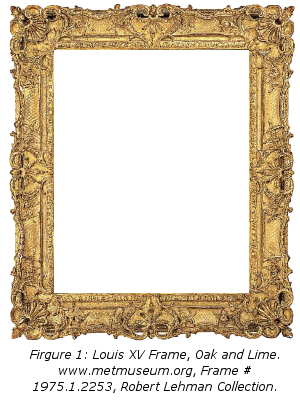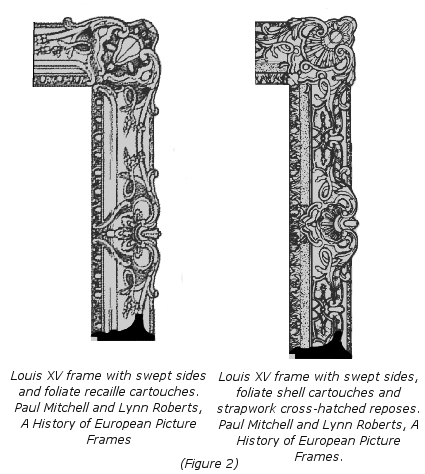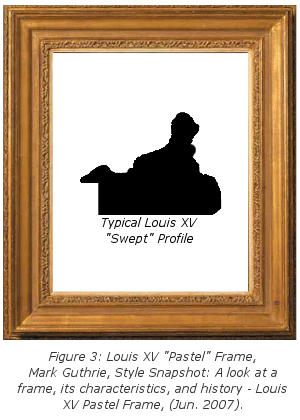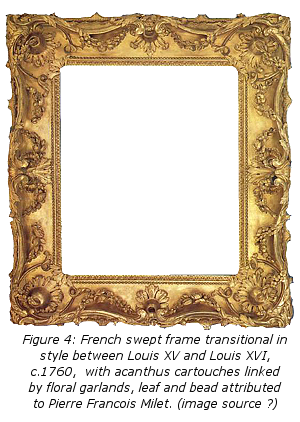"A Brief History of Frames - Rococo: Louis XV"
Author: John O'Keefe Jr.(© Copyright 2012, John O'Keefe Jr.) Publisher: Painting Frames Plus
(Published Date: 2012)
(Modified Date: 2016)
Rococo: Period: 1723-1774
In 1835 the Georgia Dictionary of the French Academy stated that the word Rococo, "usually covers the kind of ornament, style and design associated with Louis XV's reign (1715-1774) and the beginning of that of Louis XVI (1774-1793)". [1] Rococo style has been referred to as Late Baroque, however, Baroque designs became out of fashion with the emergence of the lighter elements, curves and natural patterns of Rococo. The style reached its peak in the 1730's and by 1785, Rococo had passed out of fashion in France, replaced by the order and seriousness of the Neoclassical (Louis XVI) movement.
Louis XV Frame:

Rococo designs were elegant, graceful, charming and full of curved naturalistic decoration. (figure 1) "They have deeper profiles compared to Louis XIV frames and have stronger, more pronounced corner ornamentation which is balanced by empty spaces of plain moulding. The frame-makers used sand on panels, carved open work, pierced decorations, and re-cutting of gesso to create sharper detailing. Frames became lighter and 'gayer' during this time. The top edge of frames began to swell and swirl in undulating forms which hardly touched each other. The basic characteristics of the full Rococo frame style consist of S and C-scrolls, swept rails, asymmetrical contours and cartouches. This era was a high watermark for carving, gilding and re-cutting of gesso." [2] (figure 2)

Louis XV "Pastel" Frame:
This frame is classified as a 'moulding' frame as opposed to the more recognizable 'carved' frames common to the Rococo period. The moulding could be produced in length and then cut to the size of the painting, an approach similar to the custom ready-made frame moulding that can be purchased at most frame shops today. (figure 3)

What helps to categorize this frame as a Louis XV is the profile is not the reverse-bolection (with ogee curve) that is typical of Louis XIII and Louis XIV frames, but it has incorporated a rail design, that is credited to the reign of Philippe II, during the Regence period. The rail became increasingly popular with Rococo frame-makers and was employed almost exclusively for the sweeping contours in later Rococo frames.
Louis XV / Louis XVI "Transitional" Frame:
The 1700's brought a renewed interest in the classical world, paving the way for the upcoming Neoclassical movement. Bridging the Rococo and Neoclassical periods was a transitional period (1760's through the 1770's) that merged elements from the two styles. Design elements from the Rococo, such as cartouches, and design elements from the Neoclassical, such as classical ornaments and acanthus leaves, were simultaneously used in frame design during this transitional period. (figure 4)

References:
- www.wekipedia.com, "Rococo", (Retrieved 08-13-12)
- Diane Day, A Survey of Frame History, Part IV: Louis XV and Louis XVI Frames, (Oct. 1998)
Bibliography:
- www.wekipedia.com, "Rococo", (Retrieved 08-13-12)
- Diane Day, A Survey of Frame History, Part IV: Louis XV and Louis XVI Frames, (Oct. 1998)
- Mark Guthrie, Style Snapshot: A look at a frame, its characteristics, and history - Louis XV Pastel Frame, (Jun. 2007)